I
Introduction
The Diadochic Kingdoms
No area of Western history is quite as recondite as that of the Diadochic empires, the successor-kingdoms that sprang up in the wake of Alexander the Great’s meteoric campaigns (334 – 323 BC) to subdue Asia under militaristic Hellenism. Educated people know that the unity of Alexander’s Imperium, ever tenuous and improvisatory, broke down immediately on his death, when his “companions” fell to bellicose squabbling over bleeding chunks of the whole. Of Ptolemy’s Macedonian Egypt, most educated people also probably know something – largely because the realm’s newly built Greek metropolis, Alexandria, became culturally the most important polis of the Mediterranean world, and it retained its status even after Octavian conquered Cleopatra and brought her Macedonian rump-state into Rome’s emergent world-federation. To make the transition from the historically known to the historically unknown requires, however, only that one switch focus from the Ptolemaic kingdom in the Nile Delta to its next-door neighbor, the Seleucid kingdom or state. The equivocation is deliberate. The prize that Seleucus grabbed in the wars of succession stretched in geographic space from Syria and Cilicia, and associated insular territories, eastward through portions of Mesopotamia and Asia Minor into the hinterlands of Parthia and Bactria. Nominally a kingdom, the borders of the Seleucid realm, as distinct from those of the more stable Ptolemaic kingdom in Egypt, were, like the Heraclitean river, in perpetual flux. Over the centuries, moreover, the Seleucid kingdom steadily withdrew in the direction of the sunrise, sacrificing its vulnerable western regions for the defensibility of its eastern keeps, until in its last act, as the remnant Greco-Bactrian principality, it attempted to perpetuate itself against political mortality by an exodus-through-conquest from Central Asia across the Hindu Kush into Northern India.

Seleucus I Nicator, first King of the Seleucid Rulers (reigned 305–281 BC)
In turning, then, from the Ptolemies to the Seleucids, one progresses from relative obscurity to super-obscurity, as one might progress from Antioch, a polity more or less known in the annals of Western history (it served Seleucus himself for a capital city), to Pushkalavati, a polity unknown except in obscure monographs. These murky events in half-legendary places nevertheless issued in archeologically and literarily documentable consequences that hold a meaning for the contemporary world despite their remoteness. Consider, for example, that when the Maurya emperor Ashoka (304 – 232 BC) converted to Buddhism around 250 BC and established it as his state religion, he had to promulgate his policy in the northwest provinces of his extensive kingdom in Greek as well as in the indigenous languages. As late the First Century BC, Greek communities – if not actual poleis – still existed in what would today be Pakistan and Afghanistan, the original name of whose second largest city, Alexandria, corrupted itself over the centuries into the barbarism of Kandahar. A post-Bactrian dux bellorum, Strato II, controlled a territory in the Indus Valley as late as 10 BC. Under the Seleucids and their heirs, the canons of Greek art influenced local sculpture and painting. The Bamiyan Buddhas, completed around 500 and dynamited by the Taliban in 2001, still reflected stylistic elements of Hellenistic statuary. Finally, it was through the Seleucid kingdom and its sequelae that India and the Mediterranean came into significant communication with one another so that Brahmanism and Buddhism might be known and studied by the Greek-speaking scholars of the Serapeum and something of the dialectical method might be adopted by Hindu philosophy.
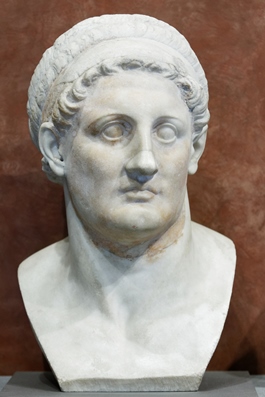
Ptolemy I Soter, founder of the Ptolemaic Dynasty (303–285 BC)
This précis of Hellenistic penetration into the Near East and Central Asia in the great age of competing empires that consummated itself in the ascendancy of Rome in the West has the purpose of introducing a modest comparative study of two seemingly unalike meditations on the theme of order in history – that of René Guénon’s Spiritual Authority & Temporal Power¹ and that of Eric Voegelin’s Ecumenic Age,² the fourth volume of that author’s five-volume Order and History (incipit 1956, with Israel and Revelation). The “Bactrian” chapter of the Alexandrian Drang nach Osten provides, perhaps surprisingly, an important object of study in both books. Voegelin (1901 – 1985) could not, of course, have been known to Guénon (1886 – 1951) and it seems relatively unlikely that this particular book by Guénon would have been known to Voegelin, who, however, might have been familiar with The Crisis of the Modern Age³ and The Reign of Quantity & the Signs of the Times;4 for Spiritual Authority is something of a sequel to The Crisis, whose topics The Reign of Quantity revisits. Of interest is that Guénon and Voegelin, while quite different in the style of their thinking, nevertheless identify in the phenomenon of the Bactrian episode, including its Indian prequel, the same historical and spiritual significances; and they see in closely similar ways the relevance of that episode to an understanding of the modern phase of Western history. It goes almost without saying that for both Guénon and Voegelin, modernity is a disorderly and corrupt period in which the dominant elites have betrayed philosophy and revelation and believe themselves anointed to remake a wicked world into a rational paradise liberated from superstition and bigotry, a project necessarily entailing the destruction of tradition. Modernity is “Gnostic,” in Voegelin’s term. Gnosticism designates a derailed type of mental activity, in spiteful rebellion against the difficulties entailed by a contrasting openness to and participation in reality. Unable to accept the givens of the first reality, Gnosticism builds a fantastic second reality, which it attempts vainly to realize. Following chronology, it is natural to begin with Guénon.
II
The View of Guénon

René Guénon as a young man.
A student of comparative religion, Guénon took lively interest in Hinduism, Brahmanism, and Buddhism. The Hindu scriptures especially provided him with a rich symbolism, which he found that he could instructively put in parallel with, among other vocabularies, that of the Platonic lexicon. Spiritual Authority & Temporal Power draws on Guénon’s knowledge of the Vedas and related documents – a propensity that can at first stymie a reader uninitiated in the specialist vocabulary. (I put myself in the category.) However, Spiritual Authority repays readerly perseverance; Guénon’s references to Plato give context to the exploration of caste not as an item of sociological but rather as one of metaphysical importance. A central political-philosophical question, who should govern, as Guénon points out, is shared by Hindu religious speculation and Platonic discourse. Guénon declares the topic of his essay to be “principles that, because they stand outside of time, can be said to possess as it were a permanent actuality.” Respecting the debate about the fundamental legitimacy of temporal offices, Guénon asserts, “the most striking thing is that nobody, on either side, seems concerned to place these questions on their ground or to distinguish in a precise way between the essential and the accidental, between necessary principles and contingent circumstances.” The petulant habit of deliberately ignoring first things by itself merely provides “a fresh example [so writes Guénon] of the confusion reigning today in all domains that we consider to be eminently characteristic of the modern world for reasons already explained in our previous works.” Guénon’s phrase for the Twentieth-Century contemporaneity of his book is “the modern deviation.”5
Where Voegelin stands out as above all an exegete of the symbols by which the West has articulated its vision of reality over the centuries, Guénon strikes one as rather more a modern mythopoeic thinker who takes symbols as his main stuff of purveyance, but this is not to say that he lacks analytical ability. Rather, Guénon grasps that symbols and myths – while they might be, as Voegelin would later call them, compact – articulate reality more fully and more truly than the clichés of modern reductive thinking and that therefore one best wrests intoxicated minds from the drug of those clichés by jerking them around (rhetorically, of course) so as to get them to face and contemplate the symbols themselves in their numinous fullness. It belongs to Guénon’s suasory strategy that the strangeness of Hindu or even European Medieval symbols can fascinate the modern subject even when, as usual, that subject diametrically misunderstands them. Get their attention, Guénon seems to say – interrupt the trance; explanations can come later. Guénon’s unblushing references to a primordial tradition, “as old as the world,” can cause him, in the case of a superficial reader, to resemble a Theosophist or a spiritualist. It is worth remembering that the hard-headed Guénon wrote studies exposing Theosophy as a “pseudo-religion” and spiritualism as mountebank hocus-pocus. But if modernity were a “deviation,” then from what would it have deviated? Although Guénon’s first chapter in Spiritual Authority bears the title “Authority and Hierarchy,” the actual topics are caste and hierarchy, two of the range of first principles that modernity has insouciantly rejected.
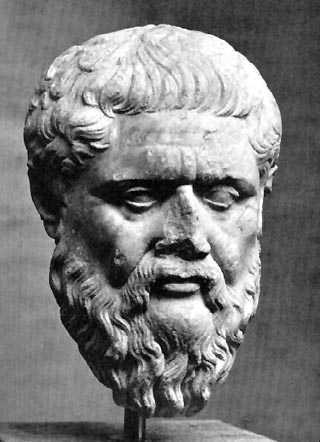
Plato (circa 428-347 BC)
Caste and authority relate to one another in complex ways. Modernity bristles at one or the other of the two terms with equal self-righteousness, but whereas traditionalists and reactionaries acknowledge the necessity of authority, they too might nevertheless feel aversion to caste, as it has manifested itself in India since the Muslim conquest. Guénon reminds his sympathetic but possibly skeptical readers that the existing caste-system of the British Raj of his time is itself a latter-day deviation and quite as acute a one as any aspect of the Western deviation into modernity. Guénon finds the true definition of caste in the Sanskrit etymologies. Accordingly, “The principle of the institution of castes, so completely misunderstood by Westerners, is nothing else but the differing natures of human individuals; it establishes among them a hierarchy the incomprehension of which only brings disorder and confusion, and it is precisely this incomprehension that is implied in the ‘egalitarian’ theory so dear to the modern world.” Additionally, “The words used to designate caste in India signify nothing but ‘individual nature,’ implying all the characteristics attaching to the ‘specific’ human nature that [differentiates] individuals from each other.” Finally, “One could say that the distinction between castes… constitutes a veritable natural classification to which the distribution of social functions necessarily corresponds.” Guénon also asserts that caste, even in the moment when it appears, suggests a fallen condition, “a rupture of the primordial unity” by which “the spiritual power and the temporal power appear separate from one another.” The assertion will disturb no one familiar with the Platonic relation between the realm of the ideas and the realm of social action; or with the Augustinian distinction between the City of God and the City of Man.
In classical Indian society, the roles of authority on the one hand and of executive power on the other fell respectively to the Brahmins, or the priestly caste, and the Kshatriyas, or the warrior caste. What is at first a harmonious functional distinction becomes, however, in the course of time, “opposition and rivalry,” or so Guénon states. The functionaries of the two castes yield to their baser instincts; they commence a struggle for absolute domination of the society. The struggle finds its outcome “in total confusion, negation, and the overthrow of all hierarchy.” Long before the climax, the real functions of the two castes have lapsed in desuetude. “As for the priesthood,” Guénon writes, “its essential function is the conservation and transmission of the traditional doctrine, in which every regular social organization finds its fundamental principles.” In rivalry with the warrior caste, the priesthood abandons “its proper attribute,” which is “wisdom.” As for the warrior caste, its essential function is active policing of right order within the society, including the maintenance of the priesthood, and defense of the society against external predation. In rivalry with the priesthood, the warrior caste repudiates its guidance under wisdom, whereupon its virtues (heroism, nobility, rectitude) become unintelligible. The rebellious warrior caste claims that no power exists superior to its own, a boast brutally plausible once the community has lost sight of transcendence and in the case “where knowledge is denied any value.”
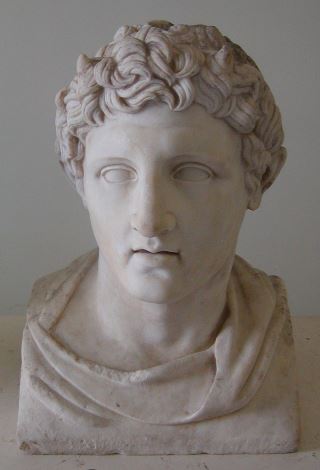
Demtetrios I of Macedon (Poliorcetes). King 294–288 BC.
In addressing the phenomenon of “insubordination,” which as he says modernity instantiates in extremis, Guénon in fact has a particular historical episode in mind, which he treats in the chapters of Spiritual Authority called “The Revolt of the Kshatriyas” and “Usurpations of Royalty and their Consequences.” Guénon cites no dates and names no names, but the episode in question belongs to the career of the Bactrian Greeks in India. A few facts will help to vivify Guénon’s purely abstract account. I take the facts from The Greeks in Bactria and India (1951) by William Woodthorpe Tarn.6 The chronology runs from the late Third Century to the middle Second Century BC. The main players on the Greco-Bactrian side of the drama are Demetrius I (reigned 200 – 190 or 180 BC); two of his sons, Demetrius II (reigned 175 – 170 BC) and Apollodotus (reigned 174 – 165 BC); and a general, Menander, who soon acquired kingship (reigned 155 – 130 BC). The two sons of the first Demetrius just mentioned, and their sons and grandsons, and Menander, ruled over Indian territories exclusively, the Bactrian Kingdom itself having succumbed by degrees to nomadic invaders (the Yueh-chi) during this period, ceasing to exist after 130 BC. The main players on the Indian side of the drama are the Maurya emperors, who were Buddhists, and their usurper-successors the Sunga emperors, beginning with Pushyamitra (reigned 185 – 149), who were Brahmins. Demetrius II, Apollodotus, and Menander were likely by profession also Buddhists.
When Demetrius I, with his sons and Menander as generals, invaded India, he was both responding opportunistically to events in Indian politics and acting on the ambition-provoking model of concupiscential militarism, as established by Alexander and the successors. As for Pushyamitra – when he deposed the last Maurya emperor by assassination, he merely continued a long-simmering civil conflict between Brahmins and Buddhists that had been begun by Chandragupta, the first Maurya emperor, who climbed to power by promoting the Buddhist Kshatriyas against the Brahmin overlord class. Tarn notes that in this period “the Brahman was the natural enemy of the Greek,” whom the priestly class categorized under the caste system as Kshatriyas. The corollary of priestly ire against the Greeks was Buddhist (that is, Kshatriya) interest in Greek military support against the Sunga dynasts. Tarn writes, “Both Apollodotus and Menander on their coins… called themselves Soter, ‘the Saviour.’” The discussion will return to the numerous implications of these details in the section on Voegelin, to follow. At this point, we will switch focus back to Guénon and Spiritual Authority.
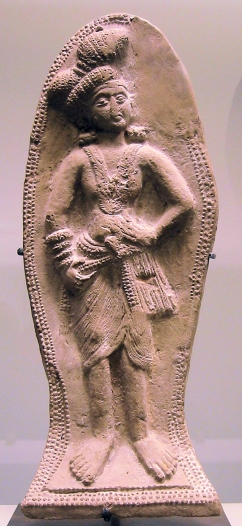
Pushyamitra Shunga (c. 185–149 BC)
In the chapter on “The Revolt of the Kshatriyas,” Guénon writes, “Among almost all peoples and throughout diverse epochs – and with mounting frequency as we approach our times – the wielders of temporal power have tried… to free themselves of all superior authority, claiming to hold their power alone, and so to separate completely the spiritual from the temporal.” When the office of the purely temporal order “becomes predominant over that representing the spiritual authority,” Guénon argues, the result will be social chaos masquerading as order under blatantly “anti-metaphysical doctrines.” A doctrine qualifies as “anti-metaphysical” for Guénon when it “denies the immutable by placing… being entirely in the world of ‘becoming.’” To deny first or transcendent principles is equivalent to submitting unconditionally to what Guénon dubs “succession.” The sequence of names in the Bactro-Indian “Who’s Who” – Chandragupta, Pushyamitra, Demetrius, Apollodotus, Menander, and Eucratides – suggests the resounding vanity of mere “succession.” Guénon reminds his readers that: “Modern ‘evolutionist’ theories … are not the only examples of this error that consists in placing all reality in ‘becoming’”; rather, “theories of this kind have existed since antiquity, notably among the Greeks, and also in certain schools of Buddhism.” Let it be noted that Guénon criticizes only the political Buddhism of the Indian Time of Troubles, not the original Buddhism of the Gautama, which “never denied … the permanent and immutable principle of … being.” Guénon implicitly also criticizes the politicized Brahmanism of the same Time of Troubles, which, entangling itself in grossly temporal affairs, forfeited its legitimacy under the law of spiritual immutability.
Guénon’s “immutable … being” is the same as reality; it is a verbal symbol of reality taken as the inalterable nature of the totality of things. To rebel against the “immutable … being” is therefore to rebel against reality, with inevitable consequences, the same in every case. As Guénon writes, the Revolt of the Kshatriyas “overshot its mark.” The immediate victors “were not able to stop it at the precise point where they could have reaped advantage from what they had set in motion.” The denial of “Atman,” the Brahmanic First Principle, led to the denial of caste, which led to the usurpation of offices by individuals unsuited to exercise them. It fell out that the Kshatriyas, in dispossessing the Brahmins, made themselves vulnerable to rebellious dispossession by the classes formerly arranged beneath them in the social hierarchy. “The denial of caste opened the door to [one and] every usurpation, and men of the lowest caste, the Shudras, were not long in taking advantage of it.” In fact, “the denial of caste” created a power-crisis in the Indus Valley and adjacent areas that eventually drew in, first, the Persians, then Alexander himself, and then in their turn the Bactrians, who were Alexander’s epigones of the nth degree, and finally a wave of nomadic invader-destroyers. A familiar theme in Indian politics, foreign occupation, has a history that begins long before the British Empire. Northern India had Greco-Bactrian rulers from the time of Demetrius II, Apollodotus, and Menander until the time of Julius Caesar in the West.
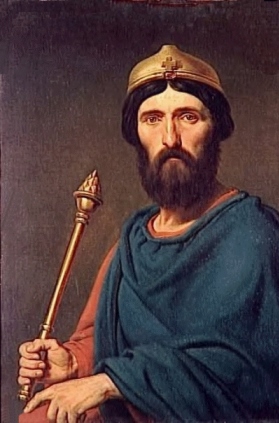
King Louis IV of France (b. 920, d. 954 AD)
Guénon insists that the Revolt of the Kshatriyas with its aftermath provides but an instance of a general pattern, pedagogically useful in its starkness, whose essential features appear, however, in other instances, as well. In the chapter in Spiritual Authority on “Usurpations of Royalty and their Consequences,” Guénon writes of “an incontestable analogy… between the social organization of India and that of the Western Middle Ages,” adding that “the castes of the one and the classes of the other” reveal how “all institutions presenting a truly traditional character rest on the same natural foundations.” Similarly, the Western Middle Ages know parallel experiences to the Revolt of the Kshatriyas. “Long before the ‘humanists’ of the Renaissance, the ‘jurists’ of Philip the Fair were already the real precursors of modern secularism; and it is to this period, that is, the beginning of the Fourteenth Century, that we must in reality trace the rupture of the Western world from its own tradition.” Even before Louis IV, Philip pursued the policy of consolidating all power in France in the kingship. Guénon writes that, “Temporal ‘centralization’ is generally the sign of an opposition to spiritual authority, the influence of which governments try to neutralize in order to substitute their own.”
The analyst may follow the line from Philip in France through the Protestants in Northern Europe, with their national churches, to the secular revolutionary movements that ensue from the Jacobin usurpation of national power in France in the events of 1789 and beyond that to the political-ideological chaos of the Twentieth Century.
III
The View of Voegelin

Eric Voegelin
The fourth volume of Order and History bears the title The Ecumenic Age. The term ecumene functions centrally in Voegelin’s theory that the order of history emerges through the history of order, that is, as successive differentiations of consciousness and the concomitant increases in noetic clarity. But what is the ecumene and what is meant by The Ecumenic Age? Etymologically, the word ecumene refers to any organized district (the English word economy shares the same Greek root); by the time of the historian Polybius (200 – 118 BC), however, the term ecumene, which Polybius uses, had come to mean any – or rather the – geographical area over which rival empires or empire-builders compete. Since by Polybius’ day this geographical area included everything that Alexander had conquered or tried to conquer in the East and everything that Rome had conquered in the West through the Third Punic War, the word effectively meant the known world, from Spain and Gaul to Bactria and India. In one of Voegelin’s several definitions in The Ecumenic Age, the ecumene arises when “empire as an enterprise of institutionalized power” becomes (in the phrase) “separated from the organization of a concrete society,” as happened for the first time in the case of Achamaenid expansion beyond the boundaries of the traditional Persian state in the Sixth Century BC. Persian conquests in the Greek field soon enough produced a reaction in the form of Alexander, who subdued Persia on his way to India; on Alexander’s death, as the discussion has previously noted, his generals tried to wrest his conquests for themselves – the result being the Diadochic kingdoms.
Voegelin writes that, “The new empires [beginning with Persia] apparently are not organized societies at all, but organizational shells that will expand indefinitely to engulf former concrete societies.” The ecumene may additionally be defined as, “the fatality of a power vacuum that attracted, and even sucked into itself, unused organizational force from outside”; and which therefore “originated in circumstances beyond control rather than in deliberate planning.”
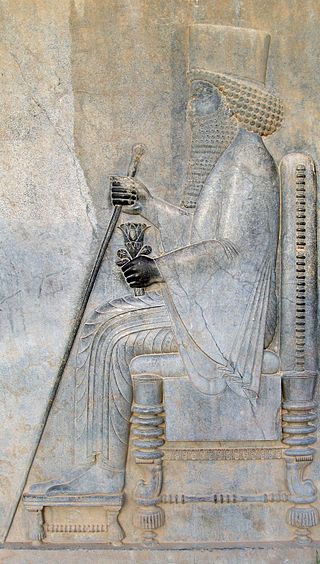
Darius I, King of Persia and Pharaoh of Egypt (b. 550, d. 486 BC)
Again in The Ecumenic Age, Voegelin writes how, in distinction to the polis, which organizes itself on the lines of a subject, the ecumene “is an object of organization rather than a subject.” This geographical-political phenomenon of the ecumene appears moreover not as “an entity given once and for all as an object for exploration,” the way the earth was given to Eratosthenes or Strabo; “it rather was something,” Voegelin writes, “that increased or diminished correlative with the expansion or contraction of imperial power” radiating from an “imperial center.” Working up to a striking phrase, “The ecumene… was not a subject of order but an object of conquest and organization; it was a graveyard of societies, including those of the conquerors, rather than a society in its own right” (emphasis added). As for the Ecumenic Age – it is the datable period, beginning with Persian expansion and ending with the disintegration of the Roman Empire in the West during which, amidst the destruction of the traditional, concrete societies, the actors of the drama forgot how to heed received wisdom while the victims of their agency had to rethink basic questions about the meaning of existence. In this way, ironically, “the Ecumenic was the age in which the great religions had their origin, and above all Christianity,” but including Buddhism, which had a Greek phase.
It will perhaps have begun to be apparent why Voegelin should take an interest in the Bactrian episode. The Bactrian episode runs its course at the farthest end of the Western ecumene, as defined by the imperial expansions of Darius and Alexander; and then in the campaign of Demetrius and his sons it replicates in miniature the concupiscential exodus that Darius and Alexander enacted in setting forth to subdue the world. In the Bactrian episode, the Western ecumene comes into contact with the Indian and the Chinese ecumenes. This contact affected India more than the West, and China hardly at all, but the episode remains instructive. “In the wake of Alexander’s campaign in the Punjab,” Voegelin writes, “the scene of imperial foundations expands to India.” In exploring the significance of the Bactrian episode, Voegelin promises to “refrain from drawing the all-too-obvious parallels with the phenomenon of imperial retreat and expansion we can observe in our own time,” a statement that naturally directs readerly attention to those very parallels. Concerning Chandragupta, whom we have already encountered in our discussion of Guénon’s Spiritual Authority, Voegelin records that, “Among other Indian princes he had come to the camp of Alexander at Patala, 325 B.C.” When the last Macedonian governor departed the Punjab in 317 BC, the ambitious prince “established himself in the new power vacuum with the help of the northwestern tribes and then descended on the kingdom of Maghada,” whose ruling dynasts he ruthlessly exterminated – man, woman, and child. Chandragupta with deft diplomacy avoided conflict when Alexander’s successor Seleucus revisited “Asia.” Concluding a treaty to fix the frontier, Chandragupta received from Seleucus one of the Macedonian’s daughters for a princess-bride; Seleucus received from Chandragupta a squadron of war-elephants.
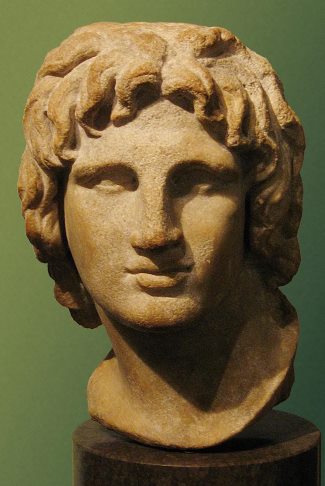
Alexander The Great, King of Macedon, Persia, Asia and Pharaoh of Egypt (b. 356, d. 323 BC)
What seemed a brilliant stroke of self-interested negotiation on the Indian’s part illustrates, in fact, Voegelin’s contention: The ecumene, not despite but because of its weird ontology, has the power to draw in those who inhabit its periphery. The attraction exerted itself reciprocally: Indians were drawn into the Seleucid and Bactrian spheres and Seleucids and Bactrians were drawn into the Indian sphere; every conqueror-usurper generated his own conqueror-usurper, and the degeneration reached its nadir in barbarian incursions and desertification of whole provinces. In Voegelin’s description, “When a general of the last Maurya ruler, Pushyamitra Sunga, assassinated his master… an imperial power vacuum was created, comparable to the earlier one, after the death of Alexander”; and “as the earlier vacuum had attracted the Maurya Chandragupta, so the present one invited Demetrius, the king of Bactria, to conquering action.” Demetrius found success in his venture partly because of the Brahmin-Buddhist split; he could appeal to the Kshatriya caste as their Soter – their “liberator” or “savior” – against the Brahmin caste. Saving and liberating belong, in Voegelin’s analysis, to a “new symbolism of the Ecumenic Age,” with the codicil that its newness equates to its degeneracy. “An age of ecumenic imperialism throws up of necessity… the curious phenomenon which is today called ‘liberation,’ i.e., the replacement of an obnoxious imperial ruler by another one who is a shade less obnoxious.”
Voegelin’s account points up the existential ironies of the Bactrian episode – naturally, because he is dealing in historical specifics – more than Guénon’s account. Demetrius having conquered India, the Seleucids saw in his absence from Bactria the ripe opportunity to reincorporate that former province. Antiochus IV sent Eucratides to complete the task; when Demetrius returned from his Indian triumph to confront the invader, he succumbed in the engagement. Voegelin speculates that Eucratides, who came with only a small army, found crucial support among the Macedonian faction in Bactria that resented Demetrius’ policy of fusion with the native Bactrians. Voegelin characterizes Eucratides as “another Savior, this time of Macedonians and Greeks from a ruler who favored the native barbarians.” While Bactria reverted temporarily to the by-now-much-truncated Seleucid kingdom, northern India found itself under Greek domination in the kingdom of Menander, who, consolidating the work of Demetrius and his sons, declared independence. In a final blow of absurdity, the Parthians invaded the re-Seleucized Bactria whereupon Eucratides fell battling them in 159 BC.

Emperor Chandragupt Maurya (b. 340, d. 297 BC)
The sequence of events that constitutes the Bactrian episode resembles the plot of one of those operas of the Late Baroque or Early Classical periods, like the Zoroastre (1749) of Jean-Philippe Rameau or the Mitridate (1770) of Wolfgang Mozart: It has five acts, plays for three hours, and boasts so many characters that the audience can hardly keep track of them while struggling to extract the meaning from the plot. The spectators leave the performance feeling dazed and disoriented. We recall that the Bactrian episode is merely a recapitulation, and to some extent an anticipation, in miniature, of the entirety of the Ecumenic Age. Voegelin writes: “During the Ecumenic Age itself … the violent diminution, destruction, and disappearance of older societies, as well as the embarrassing search, by the conquering powers, for the identity of their foundations, was the bewildering experience that engendered the ‘ecumene’ as the hitherto unsuspected subject of the historical process.” Overlooking Voegelin’s use of the term “subject” in this sentence (one of his few lapses in ambiguity) while remembering that the ecumene is an object rather than a subject it is worth examining the paradoxes that stem from the question, already posed, how to define the Polybian lexeme. “For,” as Voegelin writes, “the ecumene was not a society in concretely organized existence, but the telos of a conquest to be perpetrated.” In addition, “one could not conquer the non-existent ecumene without destroying the existent societies, and one could not destroy them without becoming aware that the new imperial society, established by destructive conquest, was just as destructible as the societies now conquered.”
The instigators of concupiscential exodus think no such thoughts; in abandoning wisdom for the purely pragmatic adventure of the conquistador they bring about the divorce in their home societies between wisdom and action – the very same divorce whose exemplar Guénon discovers in the Revolt of Kshatriyas. Voegelin’s way of describing this spiteful repudiation of wisdom and even of knowledge is the formula, “humanity contracted to its libidinous self.” Such humanity condemns itself to endure the reduction of being to becoming – to the endless and meaningless temporal succession that it instigates. And what is most wicked is that it drags the rest of humanity along with it. Voegelin sketches a phenomenology of the conqueror: “These imperial entrepreneurs of the Ecumenic Age understood the meaning of life as success … in the expansion of their power” and in no other way; worse – and tellingly – they experienced any checks against their ambitions as instances of outrageous “victimization.” They and their rhetorical sycophants also invented “the games by which the power-self makes itself the fictitious master of history,” for example, as a “Savior.” Who does think the thoughts that lead to the identification of the ecumene as existentially meaningless and intolerable?
The answer to the question of who thinks those thoughts is, obviously, the ecumene’s non-sympathetic survivors, who, however, avoid thinking of themselves in selfishly victimary terms. They are those who remember wisdom or at least remember that such a thing as wisdom exists and may be sought for even in the spiritual desert of wrecked civilizations. The meaning of history, and therefore the meaning of human existence, emerges only by exodus from the ecumene; this will be a spiritual exodus aimed at reclaiming wisdom and restoring transcendence, either to the society, should it be extant, or for the sake of a new society not yet founded, which might arise from the wreckage and accord itself with reality. Indeed, in Voegelin’s words, “the relation between the concupiscential and the spiritual exodus is the great issue of the Ecumenic Age.”
[Part II]

Prof. Thomas Bertonneau
– Thomas F. Bertonneau is an American intellectual and professor. He has taught at a variety of institutions, and has been a member of the English Faculty at State University of New York, Oswego, since 2001. His articles and essays have appeared in a diverse array of scholarly journals including William Carlos Williams Review, Wallace Stevens Journal, Studies in American Jewish Literature, North Dakota Quarterly, Michigan Academician, Paroles Gelées: UCLA French Studies, and Profils Americains. He was a major contributor to the English section of The Brussels Journal. More recently, his work has appeared in The University Bookman, the John William Pope Center for Higher Education Policy as well as the websites The People of Shambhala and The Orthosphere. He has also contributed to the Symposia of the Sydney traditionalist Forum.
Endnotes:
- René Guénon, Spiritual Authority & Temporal Power (Sophie Perennis, 2001 [1929]).
- Eric Viegelin, Order and History Volume 4 The Ecumenic Age (University of Missouri Press, 2000 [1974]).
- René Guénon, Crisis of the Modern Age (Sophie Perennis, 2001 [1927]).
- René Guénon, The Reign of Quantity & the Signs of the Times (Sophie Perennis, 2002 [1945]).
- Thomas F. Bertonneau, “The Kali Yuga: René Guenon’s Critique of Modernity” The Brussels Journal (13 December 2010) <brusselsjournal.com> (accessed 18 July 2016).
- William Woodthorpe Tarn, The Greeks in Bactria and India (Cambridge University Press, 1951).
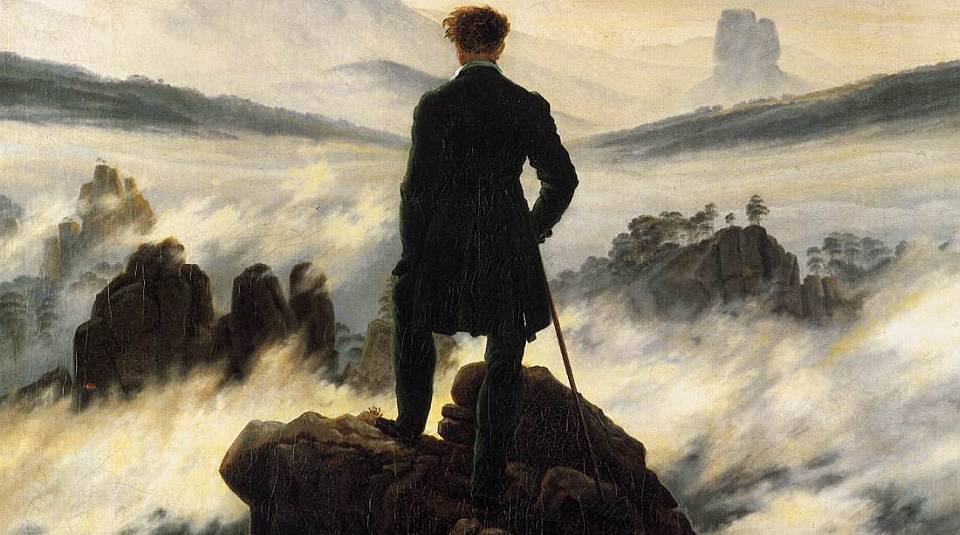

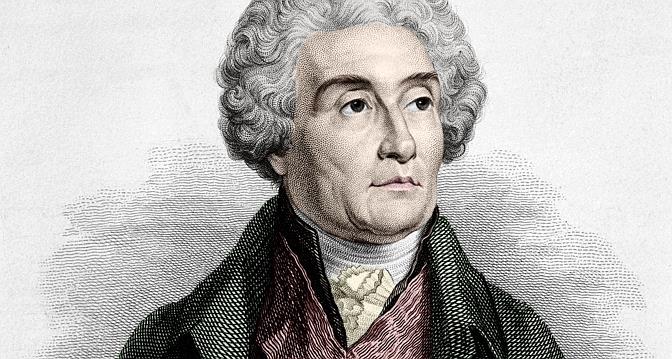


Reblogged this on deinvestiture.
Reblogged this on Êxodo Cultural.